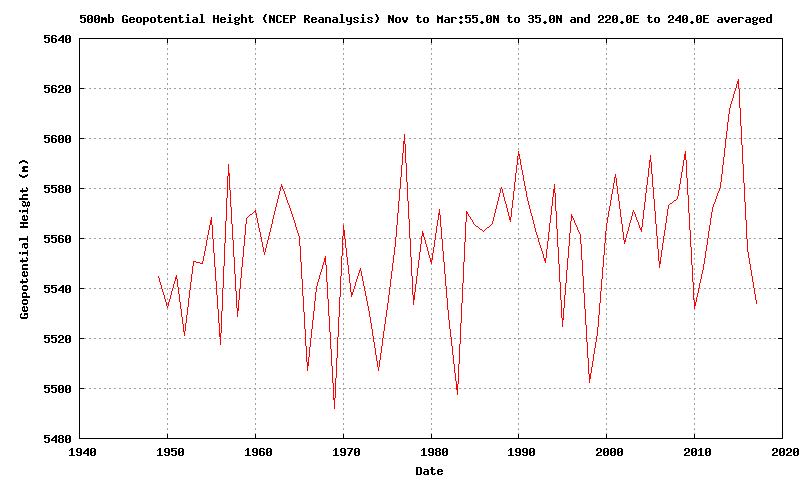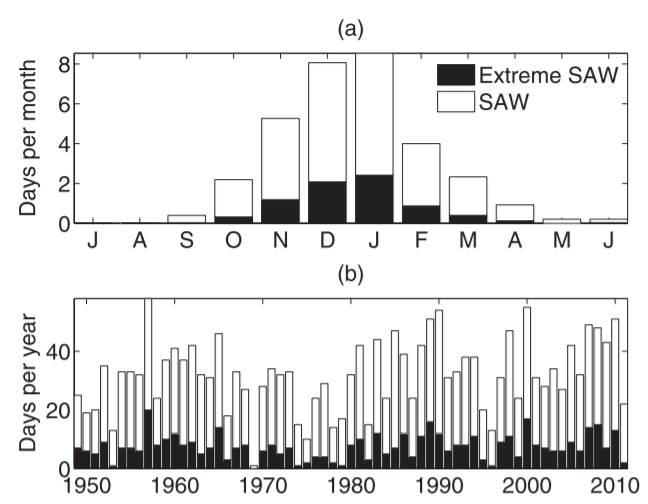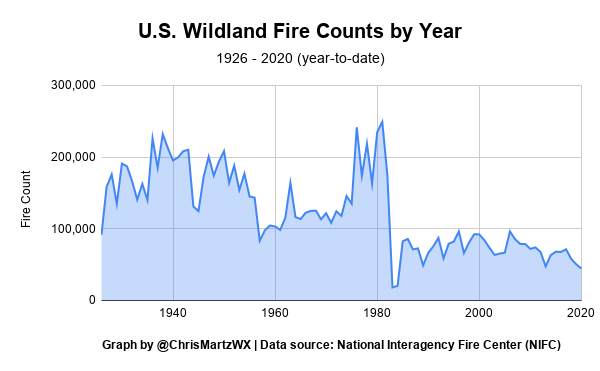Anytime there is an extreme weather or weather-related event, there never seems to be a shortage of people who immediately blame man-made climate change. You can bet your hard earned dollar that any individual who makes such obscure claims without providing any further background information, has a bit of trouble in the critical thinking department. I have found that the majority of these people aren’t scientists, but rather, are environmental activists and politicians attempting to hijack scientific research and exaggerate it into a worst-case scenario in order to push their political agenda, whatever that may be.
In recent years, there has been an ever increasing focus on the destructive wildfires that burn millions of acres annually across the West Coast of the United States. We are told that these wildland fires are becoming more frequent and more destructive as the planet warms due to greenhouse gases caused by mankind’s fossil fuel combustion. We are told that if we don’t drastically reduce our emissions and implement radical policies to “save the planet,” wildfires like we are seeing will only become more destructive in the future. Is any of this true? The best available evidence says NO. There’s no doubt that the ongoing fires blazing across the West Coast are incredibly destructive and deadly, but even in such situations, there needs to be rationality. Blaming climate change on them does nothing helpful to ease the situation. Rather, there should be talk about the decades of fire suppression practices that have ininvetiebly led to such disasters (more on that later), yet you rarely hear a peep from the press about it (Figure 1).

Anyone who lives in California will tell you that late summer through late winter / early spring are prime time for fires to break out. This has always been the case, and it always will be. This is nothing new or “unprecedented” as so many people preferably say. And, just in case you left your brain behind, it should be made clear that wildfires don’t just spontaneously ignite. There must be a “spark” to get the fire going. While lightning is responsible for the majority of natural wildfires (of which there are few), the majority of wildfires are actually. . . wait for it . . . caused by humans! Shocker.
Indeed, according to a March 2017 study published in PNAS, Balch et al. (2017), 97% of wildfires in Mediterranean California are caused by human ignitions, while 94% are human-ignited in the Marine West Coast Forests.¹ These numbers are provided in Table 1 below from the study.

In order for an existing wildfire to grow and spread, prevailing weather conditions must be favorable. Ideal environmental conditions include dry vegetation and soil; extremely high temperatures; and strong, gusty winds.
9/29 EDIT: Humidity and wind speed are far more important in determining wildfire risk than temperature. If the dew point depression (difference between the air temperature and dew point) is large, the air is dry and therefore more conducive for wildfires. If the dew point depression is small, then the air is more humid and it takes a much longer time for vegetation to dry out. It doesn’t really matter what the outside air temperature is.
In California, little precipitation falls during the summer, which allows vegetation to dry out considerably as autumn inches closer. California’s dry season comes amidst the polar jet stream retreating to the north during spring which prevents large weather systems from slamming into the West Coast. Additionally, the nearby cool Pacific waters limit the amount of water that can be evaporated into the air, lifted into the atmosphere and condensed, then precipitated back down as rain. As such, the dried out shrubbery, grass, and forests become fuel for the fire once autumn approaches and fires begin to break out.
Even if it rained considerably during the summer there, the offshore Santa Ana wind events accompanying large surface high-pressure systems (associated with either ridges or cold-core highs) would be able to dry out that vegetation within ours and spike the temperatures considerably, sometimes well into the 90s and 100s as that air is compressed and warmed adiabatically as it descends the mountain range. Therefore, even if global warming were to further dry out vegetation, it wouldn’t really matter given that it’s already dry enough at this time every year to burn.
The fire threat is expected to increase this week (Figure 2) as a dome of high pressure builds in across Western North America. With both a ridge and a surface high beneath in place, offshore flow aloft and offshore surface winds will downslope across California leading to another Santa Ana wind event.

Thus, given that summer and autumn temperatures and dryness aren’t a significant factor, the next thing we need to examine is whether or not these high pressure ridges which lead to Santa Ana wind events are increasing in frequency or not. Several atmospheric scientists and “passionate” journalists have, but a quick glance at a time series of 500 mb geopotential heights during the cool season across the region created by Dr. Cliff Mass shows that there has been no significant long-term trend to justify such claims,² especially after the late 1970s, when the Pacific Decadal Oscillation (PDO) flipped into its positive mode (Figure 3).

Given that such ridging events have not increased significantly over the last several decades, then that should be reflected in the number of Santa Ana wind days per year, and as shown in the plot below from Abatzogoul et al. (2013), there hasn’t been an increase in the 1948 to 2010 period.³

Scientists have suggested that as the planet warms in response to radiative forcing, the number of Santa Ana wind days will actually decrease by a statistically significant amount.⁴ One of the studies that suggested this was Hughes et al. (2011); the authors ran a climate model simulation at 12-km in resolution out to the mid-21st century, and found that Santa Ana wind days per winter season is about 20% fewer by the mid-21st century than they were in the late 20th century, despite an increase in temperature and a coinciding decrease in relative humidity (the latter of which is unlikely given that anthropogenic forcing indirectly adds more water vapor to the air), which are both favorable for fire weather.⁴ The reason for the decrease in Santa Ana wind days is because the thermal gradient between the interior desert and the air above the East Pacific will be reduced as the interior warms faster.⁴
“The number of Santa Ana days per winter season is approximately 20% fewer in the mid 21st century compared to the late 20th century. Since the only systematic and sustained difference between these two periods is the level of anthropogenic forcing, this effect is anthropogenic in origin.”
Human-induced changes in wind, temperature and relative humidity during Santa Ana events (Hughes et al., 2011).
From what we are bombarded with daily by the press and politicians, it would seem like wildfires in the United States are at an all-time unprecedented high. In fact, several journalists and politicians alike have made the claim that these fires are “historical.” Of course, when one actually digs into the historical record provided by the National Interagency Fire Center (NIFC),⁵ we see that United States wildfire frequency (Figure 5a) and subsequent burn acreage (Figure 5b) are nowhere near all-time record highs. Better firefighting and fire safety practices have obviously reduced the count by a large factor over the last 90+ years, but that doesn’t change the fact that fires are nowhere near as bad as they used to be.


U.S. wildland fire counts by year since 1926 (Figure 5a – left) and U.S. wildland fire burn acreage over that same time period (Figure 5b – right).
In California alone, over three million acres have burned alone this year,⁶ while the second half of the 20th century averaged only around 250,000 acres per year. While this sounds incredibly alarming, the reality is that the year-to-date burn acreage is still about one million acres away from the lowest estimate of what used to burn across the state annually before European settlers arrived (4.4 million acres), according to Stephens et al. (2007) (open access link here).⁷
Furthermore, Swetnam et al. (2016) found that the combined record of more than 800 sites located in Western North America observed very high fire frequency prior to the late 19th century than in recent decades, with a much larger variation between large and small fire years than exists today (Figure 6).⁸

In the more recent narrow scope of things, wildfires have increased in frequency and burn acreage area since the mid-1980s after being reduced drastically throughout the first half of the 20th century due to the adoption of fire suppression practices. Ultimately, fire suppression has led to a buildup of fuel by overgrown forests and an overabundance of overbrush.
After large fires continued to destroy property and forests throughout the 1910s, 1920s, and 1930s, the U.S. Forest Service put together a fire suppression policy that any wildfire should be suppressed as quickly as possible. Prior to then, Native Americans intentionally burned forests to clear out overbrush to reduce wildfire threat. They lived in harmony with nature, unlike modern society, which doesn’t. Once the natives were forced out of their home, the cycle of controlled burns was broken and forests grew. Beginning in the 1920s, fire suppression became widespread and the U.S. Forest Service actually deemed controlled burns as bad. By allowing forests to become overgrown without any controlled burns to clear out overbrush, the “fuel for the fire” built up continuously with each passing year. Essentially, it was only a matter of time before California and other West Coast states became a tinderbox.
Despite these hardcore facts which everyone should agree on, fire suppression is still occurring despite efforts to change such practices. While a lot of the land that gets burned every year is on federal property, there are a wide range of jurisdictions ranging from cities and towns to privately owned land. Tackling this issue isn’t just a responsibility of the Federal Government, it’s also a responsibility for the state governments to speak up instead of constantly and incorrectly blaming man-made climate change on these wildfires without providing any sufficient evidence to support their claims.
This is backed by several peer-reviewed studies, including Balcha et al. (2017).¹
“Ignitions caused by human activities are a substantial driver of overall fire risk to ecosystems and economies. Actions to raise awareness and increase management in regions prone to human-started wildfires should be a focus of United States policy to reduce fire risk and associated hazards.”
Human-started wildfires expand the fire niche across the United States (Balcha et al., 2017).
In summary, the science clearly shows that in the broad scheme of things, North American wildfire activity is not at all-time record highs, and that there has been no significant change in the meteorological conditions required to enhance existing wildfires. Evidence also points to the fact that even with global warming, wildfire threat will largely be determined by forest management policies, not climate change. It’s important that we change the way we manage our forests, and live in better harmony with nature to avoid these disasters regardless of what the climate does. Blaming climate change on everything that happens is not productive and contributes nothing meaningful to scientific and policy discussion.
REFERENCES
[1] Balch, J. K., Bradley, B. A., Abatzoglou, J. T., Nagy, R. C., Fusco, E. J., & Mahood, A. L. (2017). Human-started wildfires expand the fire niche across the United States. Proceedings of the National Academy of Sciences, 114(11), 2946-2951. doi:10.1073/pnas.1617394114.
[2] Mass, C. (2017, December 17). Are California Coastal Wildfires Connected With Global Warming: The Evidence Says No. Retrieved September 29, 2020, from https://cliffmass.blogspot.com/2017/12/are-california-coastal-wildfires.html.
[3] Abatzogoul, John T., et al. “Diagnosing Santa Ana Winds in Southern California with Synoptic-Scale Analysis.” March 6, 2013. Accessed October 29, 2019. https://journals.ametsoc.org/doi/pdf/10.1175/WAF-D-13-00002.1.
[4] Hughes, M., Hall, A., & Kim, J. (2011). Human-induced changes in wind, temperature and relative humidity during Santa Ana events. Climatic Change, 109(S1), 119-132. doi:10.1007/s10584-011-0300-9.
[5] Total Wildland Fires and Acres (1926-2019). (n.d.). Retrieved September 29, 2020, from https://www.nifc.gov/fireInfo/fireInfo_stats_totalFires.html.
[6] California Department of Forestry and Fire Protection (CAL FIRE). (n.d.). Stats and Events. Retrieved September 29, 2020, from https://www.fire.ca.gov/stats-events/.
[7] Stephens, S. L., Martin, R. E., & Clinton, N. E. (2007). Prehistoric fire area and emissions from California’s forests, woodlands, shrublands, and grasslands. Forest Ecology and Management, 251(3), 205-216. doi:10.1016/j.foreco.2007.06.005.
[8] Swetnam, T. W., Farella, J., Roos, C. I., Liebmann, M. J., Falk, D. A., & Allen, C. D. (2016). Multiscale perspectives of fire, climate and humans in western North America and the Jemez Mountains, USA. Philosophical Transactions of the Royal Society B: Biological Sciences, 371(1696), 20150168. doi:10.1098/rstb.2015.0168.
Categories: Weather
So when I go to the NIFC site it states the following:
“Prior to 1983, the federal wildland fire agencies did not track official wildfire data using current reporting processes. As a result, there is no official data prior to 1983 posted on this site. ”
So where did the data that you are attributing to the NIFC (prior to 1983) come from ?
LikeLike
When in doubt, use a web archive. Looks like they erased the data, but the original data is here. http://web.archive.org/web/20210125134509/https://www.nifc.gov/fireInfo/fireInfo_stats_totalFires.html
LikeLike
“Looks like they erased the data”
Agreed, but why did they do that ? Perhaps the note in the archive provides an answer:
“Prior to 1983, sources of these figures are not known, or cannot be confirmed, and were not derived from the current situation reporting process. As a result the figures prior to 1983 should not be compared to later data.”
So why are you using data that the NIFC says should not be used ? Does that change the conclusions ?
LikeLike